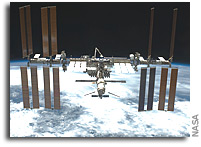NASA International Space Station Lead Increment Scientist’s Weekly Highlights June 20, 2011

After one month of continuous operations, the Alpha Magnetic Spectrometer – 02, or AMS-02, has collected data on more than 1.4 billion events and continues to collect data from 40 million cosmic rays daily. The AMS-02 uses the unique environment of space to advance knowledge of the universe and lead to the understanding of the universe’s origin by searching for antimatter, dark matter and measuring cosmic rays.
Space station astronauts continue to feed the spiders for the Commercial Generic Bioprocessing Apparatus Science Insert – 05, or CSI-05: Spiders, Fruit Flies and Directional Plant Growth. The webs the spiders are spinning are often circular. On the ground, the spiders only spin a half-circle, and never a full circle like the spiders are doing in microgravity. In addition, the spiders in space sit on their webs in all directions, whereas on the ground the spiders always sit at the top of their webs facing down towards the largest portion of their web. Fruit fly colonies continued to look healthy and video of the fruit fly movement is still being collected. This is the 3rd or 4th generation flies born in space that have never experienced gravity. Results from CSI-05 may help scientists more clearly understand how different organisms are affected by the microgravity environment.
DEvice for the study of Critical LIquids and Crystallization Alice Like Insert, or DECLIC-ALI, completed a run. The experiment studies liquids at the verge of boiling. The flow of heat during boiling events is different in microgravity than it is on Earth. Understanding how heat flows in fluids at the verge of boiling will help scientists develop cooling systems for use in microgravity. On Earth it could ultimately lead to the development of improved solvents for chemistry and the environment.
Through June 21, the Crew Earth Observation, or CEO, team has received 2,040 images. Recent images include targets in Europe and Asia. For this experiment, station crew members photograph natural and human-made changes on Earth. These images provide researchers with key data to better understand the planet.
Vic Cooley, Lead Increment Scientist Expedition 27/28








